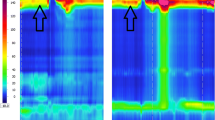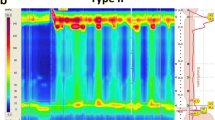Abstract
Background
Achalasia and scleroderma are esophageal motility abnormalities characterized by severely impaired bolus transit. Combined multichannel intraluminal impedance and manometry (MII-EM) enables the simultaneous measurement of intraesophageal pressures and bolus transit at various levels within the esophagus.
Aim
The aim of the study was to evaluate and characterize regional pressure and transit profile differences in scleroderma and achalasia patients.
Methods
A retrospective analysis was carried out of MII-EM studies of patients with scleroderma (15), achalasia (20), and poorly relaxing lower esophageal sphincter (LES) with normal esophageal body function (20) as a control group. Bolus presence and segmental transit were evaluated by MII.
Results
In patients with achalasia, bolus transit was impaired across all four sites compared with scleroderma (P < 0.0125) even though distal esophageal pressures were higher (P < 0.05) in patients with achalasia. Pressures in patients with achalasia were similar across all four sites (ANOVA; saline, P = 0.373; viscous, P = 0.615). Bolus clearance rates and contraction amplitudes in patients with scleroderma decreased from proximal to distal. In the control group, bolus clearance was complete during ≥83% of all swallows and esophageal pressure amplitudes increased distally.
Conclusion
While the overall bolus transit is impaired in both patients with achalasia and scleroderma regional pressure and bolus transit differences exist. Bolus transit abnormalities result from abnormal esophageal body contraction and not abnormal LES relaxation.




Similar content being viewed by others
Abbreviations
- MII-EM:
-
Multichannel intraluminal impedance esophageal manometry
- LES:
-
Lower esophageal sphincter
- NO:
-
Nitric oxide
References
Rajapakse CN, Bancewicz J, Jones CJ, Jayson MI (1981) Pharyngo-esophageal dysphagia in systemic sclerosis. Ann Rheum Dis 40:612–614
Saladin TA, French AB, Zarafonetis CJ et al (1966) Esophageal motor abnormalities in scleroderma and related diseases. Am J Dig Dis 11:522–535
Weihrauch TR, Korting GW (1982) Manometric assessment of oesophageal involvement in progressive systemic sclerosis, morphea and Raynaud’s disease. Br J Dermatol 107:325–332
Yarze JC, Varga J, Stampfl D, Castell DO, Jimenez SA (1993) Esophageal function in systemic sclerosis: a prospective evaluation of motility and acid reflux in 36 patients. Am J Gastroenterol 88(6):870–876
Paterson WG (2001) Etiology and pathogenesis of achalasia. Gastrointest Endosc Clin North Am 11:249–265
Richter JE (2004) Achalasia. In Castell DO (ed) Esophagus, 4th edn. Lippincott Williams and Wilkins, Philadelphia, pp 221–261
Dunaway PM, Maydonovitch CL, Wong RKH (2000) Characterization of esophageal muscle in patients with achalasia. Dig Dis Sci 45:285–290
Vaezi MF, Richter JE (1999) Diagnosis and management of achalasia. Am J Gastroenterol 94:3406–3412
Silny J (1991) Intraluminal multiple electric impedance procedure for measurement of gastrointestinal motility. J Gastrointest Motil 3:151–162
Silny J, Knigge KP, Fass J et al (1993) Verification of the intraluminal multiple electrical impedance measurement for recording of gastrointestinal motility. J Gastrointest Motil 5:107–122
Simren M, Silny J, Holloway R et al (2003) Relevance of ineffective oesophageal motility during oesophageal acid clearance. Gut 52:784–790
Wise JL, Murray JA, Conklin JL (2004) Regional differences in oesophageal motor function. Neurogastroenterol Motil 16:31–37
Tutuian R, Castell DO (2004) Combined multichannel intraluminal impedance and manometry clarifies esophageal functional abnormalities: study in 350 patients. Am J Gastroenterol 99(4):1011–1019
Spechler SJ, Castell DO (2001) Classification of oesophageal motility abnormalities. Gut 49:145–151
Crist J, Gidda JS, Goyal RK (1984) Intramural mechanism of esophageal peristalsis: roles of cholinergic and noncholinergic nerves. Proc Natl Acad Sci USA 81:3595–3599
Nguyen HN, Domingues GR, Winograd R, Lammert F, Silny J, Matern S (2004) Impedance characteristics of esophageal motor function in achalasia. Dis Esophagus 17(1):44–50
Hirano I, Tatum RP, Shi G, et al (2001) Manometric heterogeneity in patients with idiopathic achalasia. Gastroenterology 120:789–798
Author information
Authors and Affiliations
Corresponding author
Rights and permissions
About this article
Cite this article
Mainie, I., Tutuian, R., Patel, A. et al. Regional Esophageal Dysfunction in Scleroderma and Achalasia using Multichannel Intraluminal Impedance and Manometry. Dig Dis Sci 53, 210–216 (2008). https://doi.org/10.1007/s10620-007-9845-x
Received:
Accepted:
Published:
Issue Date:
DOI: https://doi.org/10.1007/s10620-007-9845-x




